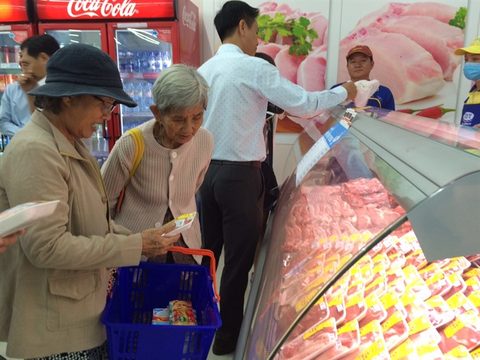Vietnam convenience stores enjoy boom
 |
| Customers shop at a newly opened Co.op Smile convenience store in HCM City’s Cu Chi District.- VNS Photo Xuan Huong |
If they reduce their prices further, they would have even more opportunities to grow, they said.
Le Viet Nga, deputy head of the Ministry of Industry and Trade’s domestic market department, said convenience stores have got a good reception from the market, and now make up the fastest growing retail segment with double-digit growth.
“This is a modern trading channel, selling goods with clear origins and having good management. Convenience stores offer good opportunities for small and medium-sized enterprises and farmers to bring their products into the market.”
According to the ministry, investors are also favouring convenience stores since their return on investment is much higher than traditional supermarkets or hypermarkets and investment is lower.
Besides, getting licences for convenience stores and minimarts is much easier than for supermarkets since opening retail outlets of less than 500sq.m is not subject to the economic needs test (ENT), it said.
Traditional retail channels still account for 72 per cent of the market but this is forecast to reduce to 60 per cent by 2020, it said.
In China there is one convenience store for every 21,000 people, while the figure is 1,800 in South Korea and 69,000 in Viet Nam, meaning there is immense potential for the segment to grow in Viet Nam, it said.
The steady increase in incomes and changes in consumer behaviour are other big factors, it added.
Intense competition
The number of convenience stores more than doubled in 2012-14 to 348. The number of minimarts went up from 863 to 1,452.
In 2015 and 2016 convenience stores continued with their impressive performance, with local and foreign players like Saigon Co.op, Satra, Vingroup, B’s mart, Shop&Go and Circle K beefing up their presence as shoppers eyed convenience while a robust economy increased their spending power.
For instance, Saigon Co.op, which owns Co.opmart, Co.opXtra and Co.op Food, last year launched Co.op Smile, a new retail model.
Saigon Co.op general director Nguyen Thanh Nhan said plans are in the works to increase the number of Co.op Smile stores to 200-300 by the end of this year from just 20 outlets last year.
Satra, which has a joint venture with Heineken in Viet Nam, also plans to expand its retail system, with a focus on developing its convenience store chain Satrafoods to create a distribution channel for its subsidiaries like meat producer Vissan and Vietnamese producers in general.
This year it will open 55 Satrafoods stores, including 10 in the Mekong Delta city of Can Tho alone, raising the total number to 172.
According to the ministry, foreign enterprises have a 70 per cent market share of convenience stores, 17 per cent of malls and supermarkets, 15 per cent of minimarts and 50 per cent of the online shopping channel.
According to insiders, the biggest disadvantage for convenience stores and minimarts is their higher prices compared to supermarkets, traditional markets, and grocery stores.
To improve their competitiveness, they must reduce prices and sell quality local products, they said.
Vu Vinh Phu, chairman of the Ha Noi Supermarkets Association, said domestic producers and distributors should develop closer links to cut intermediary costs.
According to the Global Retail Development Index (GRDI) from consulting firm A.T. Kearney, Viet Nam has been in the top 30 most attractive retail markets since 2008.
What the stars mean:
★ Poor ★ ★ Promising ★★★ Good ★★★★ Very good ★★★★★ Exceptional
Latest News
More News
- Dat Bike accelerates sustainable mobility (January 07, 2026 | 15:24)
- Innovation to support modern healthcare development (January 07, 2026 | 10:00)
- Six localities record double-digit growth as regional performance diverges in 2025 (January 06, 2026 | 18:00)
- E-commerce market undergoes transformation amid rising competition and regulation (January 06, 2026 | 17:54)
- Vietnam’s industrial output hits seven-year high in 2025 (January 06, 2026 | 17:47)
- GELEX’s credit rating outlook upgraded to 'Positive' by VIS Rating (January 06, 2026 | 16:49)
- Finance sector lays firm groundwork for 2026 after major reform (January 06, 2026 | 15:30)
- Vietnam’s seafood exports surpass $11 billion in 2025 (January 06, 2026 | 08:51)
- Vietnam GDP posts second-strongest growth since 2011 (January 06, 2026 | 08:35)
- Double-digit GDP growth within reach with shift to higher-value expansion (January 06, 2026 | 08:33)
















 Mobile Version
Mobile Version